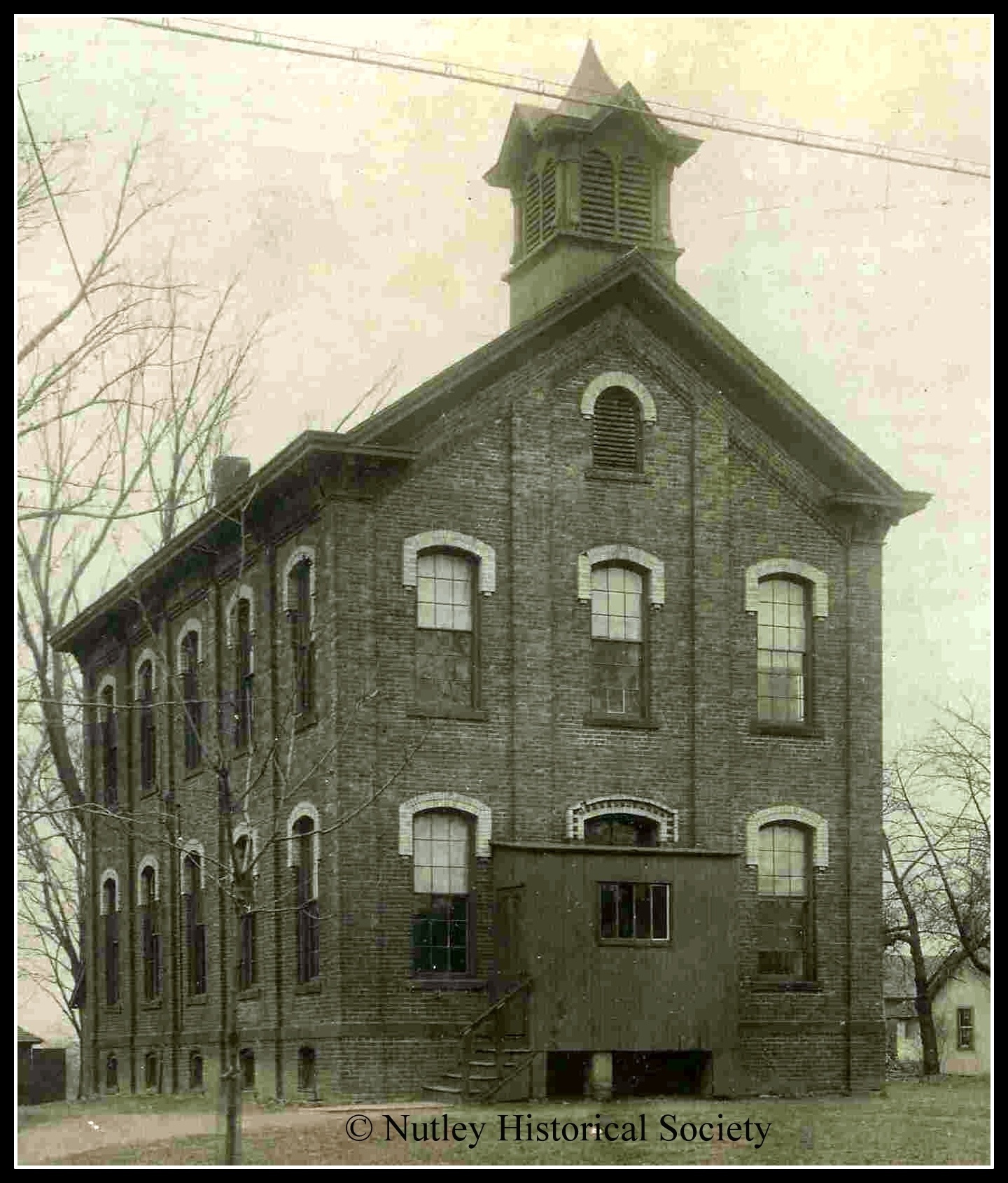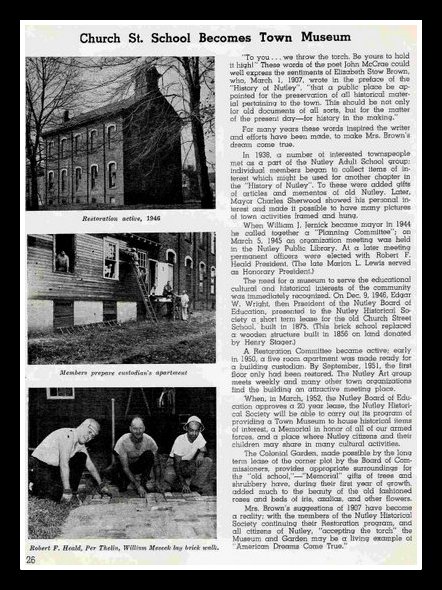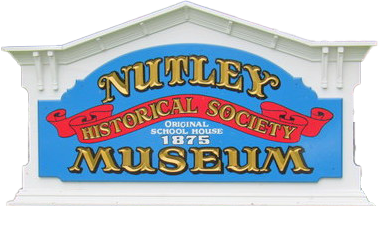MacFarland Memorial Gift and Old Bricks Being Used for New Entrance
(August 23, 1956) -- Bricks from the old Park School and a Memorial Gift helped the Nutley Historical Society to start the final projects in the Museum Restoration program. Following a sketch by James H. Bailey, masonry work on the new front porch and steps was started this week by George Ackerman.
Iron rails and appropriate meal lamps will be installed upon completion of the masonry work. Much Nutley history will be preserved by the use of the bricks secured from the Park School built in 1894.
$1,000 Memorial Gift
The memorial gift of $1,000 was presented to Miss Ann Troy for the Historical Society on March 12, 1948 by Miss Grace Maude Macfarland in memory of her mother, Mrs. Virginia Vreeland Macfarland, members of the Vreeland family whose ancestors were the oldest settlers in this area.
Mrs. Macfarland, who died on Oct. 29, 1949, had also presented a stained glass window to St. Paul's Congregational Church in memory of her mother.
Actively interested in the efforts of the Historical Society to preserve records and articles depicting Nutley's earliest days, Miss Macfarland stipulated that the gift be used at the discretion of the Society to restore the front of the building.
She requested use of a small brass plate bearing the following inscription: "In loving memory of Virginia Macfarland, 1850-1930 by daughter Grace".
Miss Macfarland was born Sept. 28, 1880, and died Oct. 29, 1949. She is survived by a sister, Mrs. Eva Adams of Maplewood.
On her mother's side of the family descended from the Lloyds of Virginia. Land owned by the Vreelands from Franklin Avenue to Vreeland Avenue has provided new streets now known as Warren Street, Adams Court and Lloyd Court.
The present site of the Bank of Nutley, Chestnut Street and Franklin Avenue, was originally the site of the home of Warren Vreeland.
The house, moved to 51 Enclosure, is now the home of Mr. and Mrs. E. W. Blodgett.
The old Church Street School was acquired by the Historical Society from the Board of Education on Feb. 3, 1947 with an annual lease.
During the first year the Society centered its efforts of repairing the slate roof and converting the wooden addition in the rear to a five room apartment for the custodians, now Mr. and Mrs. Albert Jennings.
20-Year Lease
A 20-year lease was granted on March 19, 1952, and restoration work on the first floor was put in operation.
The corner lots were leased from the Town of Nutley for use as a Colonial Garden. This attractive spot is cared for by the members of the Home Garden Club of Nutley.
Restoration of the second floor, where Museum activities are carried on, was completed in 1954 and the dedication exercises took place on Sept. 26, 1954.
The Nutley Museum is open for visitors on Sundays from 2-5 p.m. under the supervision of a volunteer committee headed by Miss Troy.
Special arrangements are made for group visits of public and parochial school classes, Cubs and Brownies and other Scout troops.
Membership in the historical society, which directs the Museum activities, is open to any one interested.
The mailing list includes Newton, Conn.; Springfield, Ohio; Fredonia, N.Y.; Brookings, S.D.; St. Petersburg, Fla.; Huntington, W. Va.; Kansas City, Mo.; and San Francisco.
The officers for the Society are Robert F. Head, president; Phillip H. Woodcock, vice-president; Miss Elsie Ryan, secretary; Miss Helene Matt, treasurer; Mrs. B. Symmonds, George Brownell, Charles S. Hammond, Harry D. Cromley, Mrs. Charles Guenzler, chairman of the Special Committees, and Miss Troy.
Source: The Nutley Sun, August 23, 1956
New York Times, Saturday, July 2, 1949
Museum Project Engrosses Nutley
Abandoned School Nearly 100 Years Old Being Converted by Historical Society
Special to The New York Times.
NUTLEY, N.J., July 1 - Restoration of an abandoned school building nearly 100 years old for conversion into a museum for the Nutley Historical Society is in full swing in this suburban community. Civic groups and public-minded citizens are solidly behind the project, which probably will be completed sometime in the fall.
A restoration fund has been started and contributions of cash or material that may be used in the restoration have been received. Donors have the privilege of requesting memorials in return for their contributions, which may be established in the form of windows, cabients, doors, flags or tablets. Included in the plans and adding to the exterior beauty of the memorial is a colonial garden. Prize roses, iris, plants and herbs from numerous gardens in the town have been promised.
Many historical buildings and documents have been preserved here. For instance, there is the Capt. Abram Speer house, built in 1760 and now occupied by Mr. and Mrs. Richard Tench. Of stalwart brick and beamed construction, the home stands on its original foundation. Another old-timer is the Vreeland homestead, built in 1702. The ivy-covered cottage is now the home fo the Nutley Woman's Club, which took title to it in 1912.
Nutley's Town Hall has an interesting background. Back in 1850 the building was a flourishing woolen mill, owned by William Duncan. Somewhere in the Eighteen Eighties two famous names in the merchandise field of today, Hicks Arnold and James and Frederick Constable of New York City, took over the mill. These fames "merchant princes" used the mill for the manufacture of articles sold in the Arnold Constable store in the big city.
The property was deeded back to the town when the need for school space became acute, and the 12-acre site was sold for $15,000. Today a modern athletic field, fire and police headquarters, public library, the junior and senior high schools, and a war memorial are all situated on the site, in addition to the Town Hall.
When the museum opens there will be an honored place for records telling the story of one of Nutley's famed residents, Annie Oakley. Acclaim and medals from all over the world were bestowed upon "Little Miss Sure Shot," the star of Buffalo Bill's Wild West Show, who late in her career came to Nutley to settle down with her husband, Frank Butler.
Stories portray her as the aggressive teen-agers of the Eighties but Nutley remembers her as a quiet, reserved woman who tool pleasure in entertaining the neighborhood children with her fancy shooting. When her house was demolished in 1937, the anecdote telling of the "house without closets" became town gossip. It seems Annie Oakley was so accustomed to traveling and living out of a trunk that it never occurred to her to have closets built in their home.
